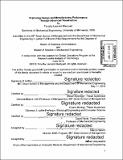| dc.contributor.advisor | Steven Eppinger and Duane Boning. | en_US |
| dc.contributor.author | Marquart, Timothy Leonard | en_US |
| dc.contributor.other | Leaders for Global Operations Program. | en_US |
| dc.date.accessioned | 2018-09-17T15:51:55Z | |
| dc.date.available | 2018-09-17T15:51:55Z | |
| dc.date.copyright | 2018 | en_US |
| dc.date.issued | 2018 | en_US |
| dc.identifier.uri | http://hdl.handle.net/1721.1/117967 | |
| dc.description | Thesis: M.B.A., Massachusetts Institute of Technology, Sloan School of Management, in conjunction with the Leaders for Global Operations Program at MIT, 2018. | en_US |
| dc.description | Thesis: S.M., Massachusetts Institute of Technology, Department of Mechanical Engineering, in conjunction with the Leaders for Global Operations Program at MIT, 2018. | en_US |
| dc.description | Cataloged from PDF version of thesis. | en_US |
| dc.description | Includes bibliographical references (pages 75-76). | en_US |
| dc.description.abstract | Visualization technology is advancing at an impressive rate, and Raytheon is investing heavily in the technology to improve product performance and manufacturability. Raytheon Missile Systems (RMS) has recently upgraded their visualization space, called a CAVE (Computer Aided Visualization Environment), to a state of the art facility with over 500 square feet of advanced visualization screen space. This is part of an overall corporate effort to improve visualization capabilities; there are similar facilities in Massachusetts and Australia, with plans to add more in Alabama, Texas, and beyond. The RMS CAVE contains a stereoscopic 3D display with cutting edge immersive technology for large scale 3D visualization of hardware and facilities. The CAVE hosts a wide variety of design review events across the whole product lifecycle focused on product design and manufacturing, as well as facility / factory modernization. This work explores the use cases taking place in the CAVE, both established and experimental. Established use cases are design for manufacturing and assembly (DFMA) reviews, facility reviews, and demonstrations. New use cases introduced include 2D data immersion reviews, and VR based training. Despite the strong value that the CAVE was providing to those who used it, it was underutilized. The CAVE utilization was only 30%-50% at the inception of this work, leaving ample capacity to host additional events. The focus of this project is to understand and leverage the RMS CAVE in Tucson, AZ to its full potential by increasing utilization and maximizing the value of meetings taking place in the CAVE. To do this, we document the value proposition, and identify novel use cases to improve utilization and effectiveness of the CAVE. The CAVE value proposition is comprised of five main elements - immersive 3D, visual real estate, collaboration and engagement, context and decision making, and improved efficiency. The CAVE has historically been used as an immersive 3D environment, and this is reflected in the current use cases, which heavily leverage 3D content. While immersive 3D content is valuable, user research reveals that the ability to have a large amount of critical information in one place is just as important. To leverage this underutilized capability, the Immersive Design Center (IDC) team held four brainstorming sessions to identify relevant events that could be enhanced through use of the CAVE. Implementation of recommendations from these brainstorming sessions has resulted in a utilization increase from an average of 32% to an average of 67% in only a few months. Furthermore, analysis indicates the majority of this increase is a result of newly identified use cases. Qualitatively, groups have been more engaged, and collaboration has been much stronger than in a traditional meeting space. These qualitative benefits materialize into tangible savings, with comparable facilities recouping initial investment costs in only six months. Raytheon has identified specific savings related to design for manufacturing and assembly (DFMA) reviews, laser scanning and facility reviews, and increased meeting efficiency. Results indicate that meetings are running 30% faster in the CAVE when compared to a traditional meeting space. We also explore a case study in virtual reality training, considering the application, customer feedback, and the business case. Feedback was positive, but there are several business strategy factors to consider including development costs, updates due to assembly process improvements, and commercial structure. | en_US |
| dc.description.statementofresponsibility | by Timothy Leonard Marquart. | en_US |
| dc.format.extent | 76 pages | en_US |
| dc.language.iso | eng | en_US |
| dc.publisher | Massachusetts Institute of Technology | en_US |
| dc.rights | MIT theses are protected by copyright. They may be viewed, downloaded, or printed from this source but further reproduction or distribution in any format is prohibited without written permission. | en_US |
| dc.rights.uri | http://dspace.mit.edu/handle/1721.1/7582 | en_US |
| dc.subject | Sloan School of Management. | en_US |
| dc.subject | Mechanical Engineering. | en_US |
| dc.subject | Leaders for Global Operations Program. | en_US |
| dc.title | Improving design and manufacturing performance through advanced visualization | en_US |
| dc.type | Thesis | en_US |
| dc.description.degree | M.B.A. | en_US |
| dc.description.degree | S.M. | en_US |
| dc.contributor.department | Leaders for Global Operations Program at MIT | en_US |
| dc.contributor.department | Massachusetts Institute of Technology. Department of Mechanical Engineering | |
| dc.contributor.department | Sloan School of Management | |
| dc.identifier.oclc | 1051237850 | en_US |
